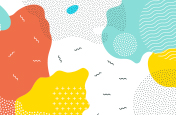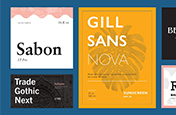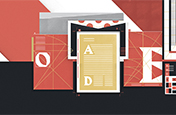How to become a UX designer
UX design is at the forefront of making digital content easy and rewarding to navigate. Find out what UX designers are, how to build a UX design portfolio, and the kind of salary you can expect to earn here.
If you’re interested in pursuing this creative career, we’ll explore how you can go about acquiring all the necessary skills and experience to become a UX designer.

What is an UX designer?
UX designer is short for “user experience designer”. As the name implies, these professionals are responsible for the overall experience someone has when interacting with a brand’s website, app or wider content - whether that’s to make a purchase, find information or use a service.
If a website has a good UX design process, it will be easy and enjoyable to navigate, helping the user find what they’re looking for.
Meanwhile, poor UX can be confusing, leading the user to the wrong product or service or even causing them to go round in circles. This can negatively affect someone’s perception of an organisation or company.
The precise role of an UX designer can, however, vary from industry to industry and even website to website.
What is an UX vs an UI designer?
UX and UI designers perform related but generally separate jobs.
- While both focus on making a digital product or site easy to navigate, their roles and responsibilities differ.
- UI is concerned with the interface of a digital product, which is how someone interacts with an app, tool or even a video game, for example.
We’ve broken down the differences to make it easy to compare UX vs UI designers:
UX Designer
UI Designer
Acronym meaning
User experience
User interface
Responsible for
Creating a user-friendly experience
Construction of the product or service interface
Focus
The full experience from the first user contact to the last
Specific touchpoints that the user interacts with on the journey
Design elements
Solutions to pain points along the user journey
Typography, colour palettes, animations, buttons and imagery
Creative goals
Effectiveness
Aesthetics

An UX designer looks to ensure the overall positive satisfaction of users when they interact with a website or digital product. Their job is to streamline user journeys and perfect site accessibility.
Key responsibilities
When looking at how to become an UX designer, it’s important to understand some of the key responsibilities. From creative skills to analytical techniques and mastering UX design tools, here’s what you can expect to fall under an UX designer’s role:
- Understanding the brand. UX specialists need to fully understand the brand they’re working for, and the product/s they’re trying to sell. What are the company’s USPs, target audience and brand identity? These are all important elements of the UX design process that will help to shape the user experience.
- Understanding the user. Once they know the brand, UX designers then need to fully understand their audience. What motivates them, why are they interacting with the brand or service and what pain points do they experience? The designer’s job is to utilise UX audience research methods and data to work out how to overcome these issues.
- Analysing learnings. UX designers combine these insights to build user personas and map what is known as ‘user flow’ - the path the user takes to reach a desired outcome. With eCommerce websites, for example, this considers the journey from landing on the website to completing a purchase. Here, good UX can seamlessly integrate with strong web development and design.
- Mapping and building. Designing the user flow involves creating site maps, wireframes and prototypes. This part of the UX design process demonstrates to the wider design team and other stakeholders how the final product will look.
- User testing. Once the user flow has been mapped, it needs to be tested to validate the design works for the end-user. User testing sees real people interacting with the product or website to identify any problems before it’s implemented in the real world.
- Presenting. An often-overlooked requirement is presentations. Once the solution has been planned, mapped and designed, it’s important to get client or internal approval. This usually involves presenting designs to the client or a creative director. It’s an opportunity to talk them through the user journey and sell the overall concept.
Working hours and what to expect as a UX designer

UX designers generally work standard office hours — 9.00 am to 5.30 pm, Monday to Friday. There might be times when you would be expected to work late to hit a deadline, but you can often rely on your responsibilities being achievable within the usual working day.
Of course, freelance UX designers can sometimes set their own hours. However, your schedule could vary depending on the amount of work you have coming in, plus client commitments.
UX designer salary and earnings
UX specialists can earn a very respectable wage in the UK, depending on experience. Indeed, the national average salary for UX designers is currently £42,000 to £55,000 every year . It’s important to note that this may be skewed by higher salaries in big cities like London(1).
This will also vary depending on the company, the city you work in, whether you’re full-time and your experience level. As a guideline, here’s what you can expect from an UX designer salary(2):
- Junior UX designer salary is typically around £29,000.
- Experienced UX designer salary is around £48,000.
- Senior UX designer salary can be £65,000 and over. At this point, your job title might change to reflect your seniority. UX Architect or Head of UX Design Department might be the logical next steps.
UX vs UI designer salary
UX and UI designer salaries are similar in the UK, but UX specialists tend to earn more - around £48,000(3) on average compared to roughly £43,000 for UI(4).
(1) - glassdoor.co.uk/Salaries/ux-designer-salary-SRCH_KO0,11.htm
(2) - glassdoor.co.uk/Salaries/ux-designer-salary-SRCH_KO0,11.htm
(3) - glassdoor.co.uk/Salaries/ux-designer-salary-SRCH_KO0,11.htm
(4) - uk.indeed.com/career/user-interface-designer/salaries
Guidance on how to become an UX designer
While many people who pursue a career in user experience start out in design, there’s no single path to becoming an UX designer. It’s key to have a creative mind, a passion for working with digital sites and UX design tools and a drive to acquire the necessary skills.
Learn the fundamentals of the UX design process.

Some user experience design fundamentals to get to grips with include:
- Wireframing and prototyping
- UX research methods
- Digital marketing/business strategy
- Visual language basics
When it comes to knowledge, everything from understanding colour meaning to developing core design thinking will help you on the road to being a fully-fledged UX designer.
Formal courses and UX design certifications are another great way to develop these skills. Universities offer many UX-related bachelor’s and master’s degrees. But, if you’re looking to fast-track a career in user experience, you may want to consider taking an online design course or watching a masterclass.
Learn how to use UX design tools
Wireframing tools, such as Adobe XD, are essential to master. Start practising with them to hone your skills and get a feel for how you might apply them in a professional setting.
Gain hands-on experience
It’s one thing to know how to execute UX projects in theory. It’s another to put that knowledge into practice. If you want to become an UX designer from scratch, you’ll need to practise and refine your skills.
You could start by:
- Gaining hands-on experience in an entry-level role
- Freelancing on small projects
- Finding internship opportunities
Create an UX design portfolio
Once you’ve developed your skills and gained some experience, the next step is to create an UX design portfolio. This helps to showcase your work to potential clients and employers. An effective UX design portfolio provides a genuine reflection of your experience - make sure that you include the results of your work and client testimonials.
Gain qualifications
Many UX designers haven't got a degree and it’s possible to build a career in user experience without one. Relevant, hands-on experience and transferable skills can all set you up for a successful career in UX.
However, some employers do prefer candidates with a bachelor’s degree in an UX-related field - and you’ll often find having a degree can open up more job opportunities.
UX design skills
To become an UX designer, you’ll need to develop the core skills necessary to the role, which include a combination of technical (‘hard’) and general (‘soft’) skills - from an understanding of design principles to keen problem-solving abilities.
Hard skills
- UX research methods and strategy. User research is vital for determining users’ needs and predicting how they’ll interact with and respond to a finished product.
- Wireframing and prototyping. UX designers need to understand how users navigate and interact with information. They should also be proficient with UX design tools like wireframes and prototypes and familiar with industry-leading tools such as Adobe XD.
- Responsive web design. UX designers should be familiar with responsive design. You need to be able to ‘optimise’ your content so that it’s accessible and displays seamlessly across devices. This is increasingly important, as half of all website traffic is now generated by mobile apps or browsers.
Soft skills
- Project management. Understanding the UX design process and knowing how to take a project from initial ideation through to delivery is essential. Not only are you responsible for the development of the user journey in practice, but you’ll also often be leading, co-ordinating and delivering the UX elements too.
- Collaboration and communication. UX designers collaborate with a diverse group of individuals within an organisation, from graphic designers to product managers. Effective communication skills are, therefore, key.
UX vs UI designer skills
While UX and UI professionals often work on the same projects, they each require unique skill sets.
- UX designers typically have experience organising and executing research, as well as building wireframes to test out insights.
- UI specialists tend to require skills in visual interfacing, such as layout design, typography, colour theory and A/B testing.
UI/UX roles do share skills, but it’s how these are utilised that tends to be different.
UX designer career prospects and other useful information

How in demand are UX designers? What are the UX design job prospects like?
Today, the demand for UX designers is increasing. According to LinkedIn, UX design is a highly sought-after and in-demand job role(5).
Who are the key employers in this field?
The UX design process has become an integral part of modern business. You’ll often find that many creative agencies and marketing companies will be looking for employees in this field. Freelancing is also a popular option, giving you the freedom to work flexibly, set your own schedule and be your own boss.
What are the pros and cons of becoming an UX designer?
As with any creative discipline, a career in UX design has its share of benefits and challenges:
Benefits:
- You’ll learn a lot on the job
- You’ll get to collaborate with others
- You can go freelance.
- When working for a reputable marketing agency, you’ll have the chance to partner with multiple brands.
- There can be a great work-life balance. Some places may offer you a remote or hybrid position, so you can work from wherever suits you best.
Challenges:
- Working to tight deadlines.
- Requires time and patience.
- You’ll need to stay on top of the latest design trends and innovations.
- Building a strong UX design portfolio is a must and takes time.
(5) - linkedin.com/pulse/ui-ux-design-good-career-2024-designerrsacademy-puprc
Begin your creative career journey with Photoshop
Start getting creative and build a strong designer portfolio with Adobe’s innovative suite of tools and features on Photoshop.
UX designer: FAQs
Do UX or UI designers make more?
UX and UI salaries are similar in the UK, but UX designers tend to earn slightly more. Average UI earnings are around £43,000, while a typical salary for an experienced UX designer will top £48,000.
Is UX a good career?
Yes, UX can be a great career for creative-minded people. Given the growing demand for UX designers and variety of entry points into the field, it can offer strong prospects for those seeking a well-paid job. UX is also a creative and flexible career path, giving you the option to go freelance or work remotely at a time and place that suits you.
What hard skills do you need for UX design?
Good UX designers will be proficient in technical skills and research methods such as wireframing, prototyping and usability testing. Experience with web tools, such as Adobe XD, is also recommended.
You might also be interested in…
Understanding black and white as colours.
Investigate the science of colours and see what sets black and white apart.
Learn about the versatility of this file format and discover how to use it in your design work.
Picking the right font: Serif vs. sans serif.
Choosing between serif or sans serif fonts means considering user experience, attitude and history.
Explore inspiration to help fuel your logo ideas.
Dive into the technical and aesthetic concerns of distilling a brand into a symbol.



